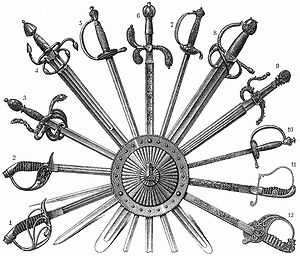Sword of Attila
The Sword of Attila, also called the Sword of Mars or Sword of God (Hungarian: Isten kardja) was the legendary weapon carried by Attila the Hun. The Roman historian Jordanes, quoting the work of the historian Priscus, gave the story of its origin:
"When a certain shepherd beheld one heifer of his flock limping and could find no cause for this wound, he anxiously followed the trail of blood and at length came to a sword it had unwittingly trampled while nibbling the grass. He dug it up and took it straight to Attila. He rejoiced at this gift and, being ambitious, thought he had been appointed ruler of the whole world, and that through the sword of Mars supremacy in all wars was assured to him."[1]
The use of "Mars" here is due to the interpretatio romana of Priscus, however, as the Huns would not have adopted the names of Roman deities; the more likely name used by the Huns would have been the more generic "sword of the war god;" (Historical sources of the Han Dynasty tell us that the Asian Huns or Xiongnu had one God, "Cheng Li", which in Altaic languages is pronounced "Tengri"[2])Hungarian legends refer to it simply as "az Isten kardja," the sword of God. Priscus's description is also notable for describing how Attila used it as both a military weapon and a symbol of divine favor, which may have contributed to his reputation as "the Scourge of God," a divinely-appointed punisher. As historian Edward Gibbon elaborated, "the vigour with which Attila wielded the sword of Mars, convinced the world that it had been reserved alone for his invincible arm."[3] In this way it became somewhat of a sceptre as well, representing Attila's right to rulership.
In the eleventh century, some five hundred years after the death of Attila, a sword claimed to have belonged to him surfaced, according to Lambert of Hersfeld,[4] who attributed its provenance to the recently established Árpád kings of Hungary, who appropriated the cult of Attila and linked a claimed descent from him with their right to rule.[5] The occasion was the unfortunate death of Leopold de Merspurg,[6] a counsellor to the king, who fell from his horse and was impaled upon his own sword. The sword's history given by Johann Pistorius, was that it had been given by the queen-mother[7] of King Salomon to Otho, Duke of Bavaria, who had urged the emperor to reinstate Salomon's possessions. Otho had given it to Dedus, younger son of the margrave Dedus, after whose death it had come to the king,[8] who had given it to Leopold, whose death— it was asserted by partisans of his rival Otho— had been a divine judgment.
There is no evidence to substantiate these medieval claims of its origin with Attila; the sword, in the Kunsthistorisches Museum, Vienna, as part of the Habsburg Schatzkammer in fact appears to be the work of ninth or tenth century Hungarian goldsmiths.[9]
The real historical events of the discovery of this sword will probably remain unknown. More information about the origin of the sword is a legend about a locality of finding, see Miholjanec#Legend, because before this legend had been regarded, this sword was known as the sword of Charlemagne known as "Joyeuse".[10]
See also
- List of historical swords
- Attila the Hun
- Hunnic Empire
References
- ↑ Jordanes, The Origin and Deeds of the Goths ch. XXXV (e-text))
- ↑ Encyclopedia, New World. "Tengri". New World Encylcopedia. Academic Publishing. Retrieved 2014-12-30.
- ↑ The History of the Decline and Fall of The Roman Empire vol. 3 Ch. XXXIV Part 1
- ↑ Lambertus, in Johann Pistorius, Illustrium Veterum Scriptorum, qui rerum a Germanis... (Frankfurt 1613), quoted in William Herbert, Attila, King of the Huns (London: Bohn) 1838:350f.
- ↑ Patrick Howarth, Attila, King of the Huns : Man and Myth 1995:183f.
- ↑ Merseburg perhaps.
- ↑ She would have been Anastasia of Kiev, a daughter of Grand Duke Yaroslav I the Wise of Kiev.
- ↑ William Herbert notes that this would have been Henry IV, Holy Roman Emperor.
- ↑ Hermann Fillitz, Die Schatzkammer in Wien: Symbole abendländischen Kaisertums; ChicagoHungarians.com Illustration of the Vienna Kunsthistorisches Museum's ninth-tenth century "Sword of God"
- ↑ European weapons and armour : from the Renaissance to the industrial revolution, page 151, R Ewart Oakeshott, North Hollywood, Calif. : Beinfeld Pub., 1980. ISBN 978-0-917714-27-6
External links
| |||||||||||||||||||||||||||||||||
